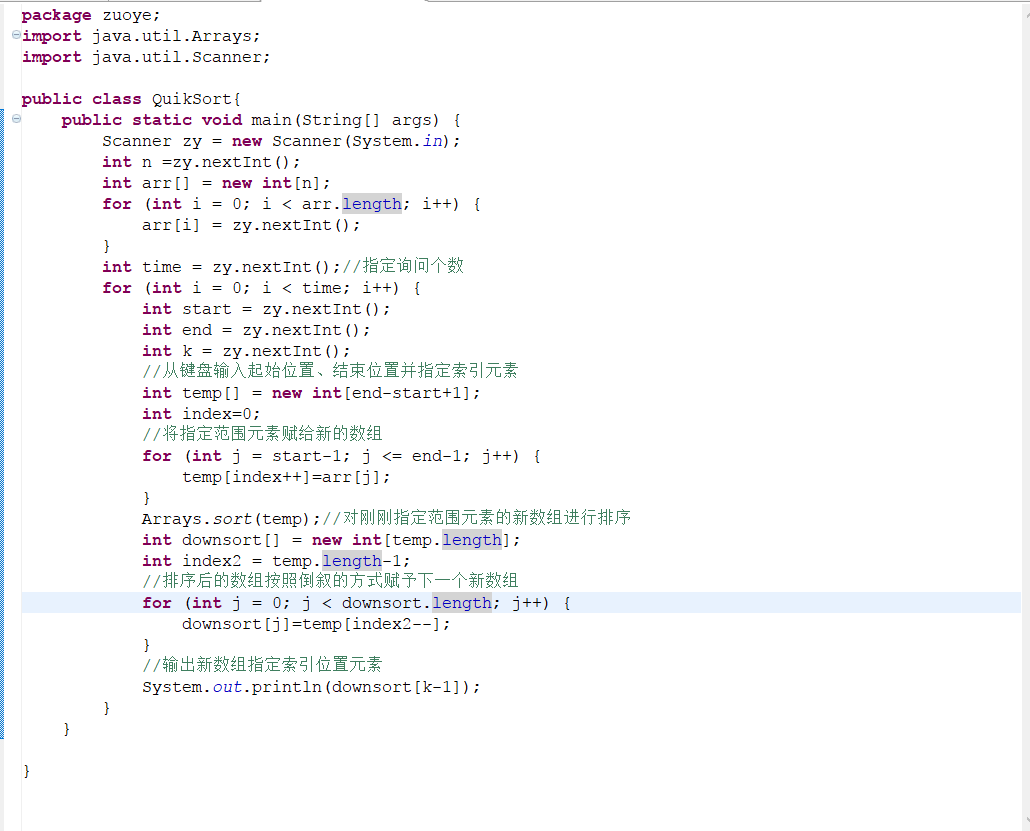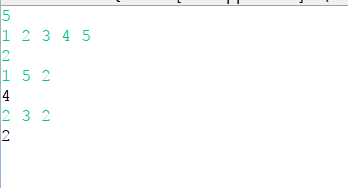2020软件工程作业04
| 这个作业属于那个课程 | https://edu.cnblogs.com/campus/zswxy/2018SE/ |
| ---- | ---- | ---- |
| 这个作业要求在哪 | https://edu.cnblogs.com/campus/zswxy/2018SE/homework/11406 | |
|这个作业的目标 |知道什么是算法,会用算法 | ---- |
| 学号 |20189641 | ---- |
题目名称
第一题:寻找数组中第K大是数 考察算法:排序算法
解题思路
使用myeclipse对数组进行排序,然后遍历一遍就可以找到第K大的数字。该方法的时间复杂度为O(N*logN)
解题代码


题目名称
第二题:二叉树的先、中、后序遍历与层级遍历 考察算法: dfs + bfs搜索算法
解题思路
先序遍历:首先访问根节点,然后先序遍历其右子树,再先序遍历其左子树;
中序遍历:首先中序遍历根节点的左子树麻烦后访问根节点,最后中序遍历其右子树;
后序遍历:首先后序遍历根节点的左子树,然后后序遍历根节点的右子树,左后访问根节点。
package zuoye01;
import java.util.LinkedList;
public class Test {
public static void main(String[] args) {
/*
作业要求:叉树的先、中、后 序遍历与层级遍历
自己实现四个方法,main方法中调用,将结果打印到控制台
*/
/* 二叉树的结构
A
/ \
T 6
/
D
/ \
N 5
/ \ /
B 4 1
\
9
*/
Node root = into();
// 先序遍历
System.out.print("先序遍历:");
A(root);
System.out.println();
// 中序遍历
System.out.print("中序遍历:");
B(root);
System.out.println();
// 后续遍历
System.out.print("后序遍历:");
C(root);
System.out.println();
// 层级遍历
System.out.print("层级遍历:");
D(root);
}
private static void A(Node root) {
// TODO 先序遍历
if (root != null) {
System.out.print(root.data);
A(root.l);
A(root.r);
}
}
private static void B(Node root) {
// TODO 中序遍历
if (root != null) {
B(root.l);
System.out.print(root.data);
B(root.r);
}
}
private static void C(Node root) {
// TODO 后序遍历
if (root != null) {
C(root.l);
C(root.r);
System.out.print(root.data);
}
}
private static void D(Node root) {
// TODO 层级遍历
if (root != null) {
LinkedList<Node> linkedList = new LinkedList<Node>();
//先将根节点入队
linkedList.offer(root);
Node node = null;
while (!linkedList.isEmpty()) {
node = (Node) linkedList.pop();
System.out.print(node.data);
if (node.l != null) {
//将出队结点的左子树根入队
linkedList.offer(node.l);
}
if (node.r != null) {
//将出队结点的右子树根入队
linkedList.offer(node.r);
}
}
}
}
// 构建一颗树,返回根节点
private static Node into(){
Node root = new Node("A");
Node node1 = new Node("T");
Node node2 = new Node("D");
Node node3 = new Node("N");
Node node4 = new Node("B");
Node node5 = new Node("6");
Node node6 = new Node("5");
Node node7 = new Node("4");
Node node8 = new Node("9");
Node node9 = new Node("1");
root.l = node1;
node1.l = node2;
node2.l = node3;
node2.r = node6;
node3.r = node7;
node7.r = node8;
node6.l = node9;
node3.l = node4;
root.r = node5;
return root;
}
// 节点
static class Node{
// 数据
Object data;
// 左孩子
Node l;
// 右孩子
Node r;
public Node(){}
public Node(Object data) {
this.data = data;
this.l = null;
this.r = null;
}
public Node(Object data, Node l, Node r) {
this.data = data;
this.l = l;
this.r = r;
}
}
}



 浙公网安备 33010602011771号
浙公网安备 33010602011771号